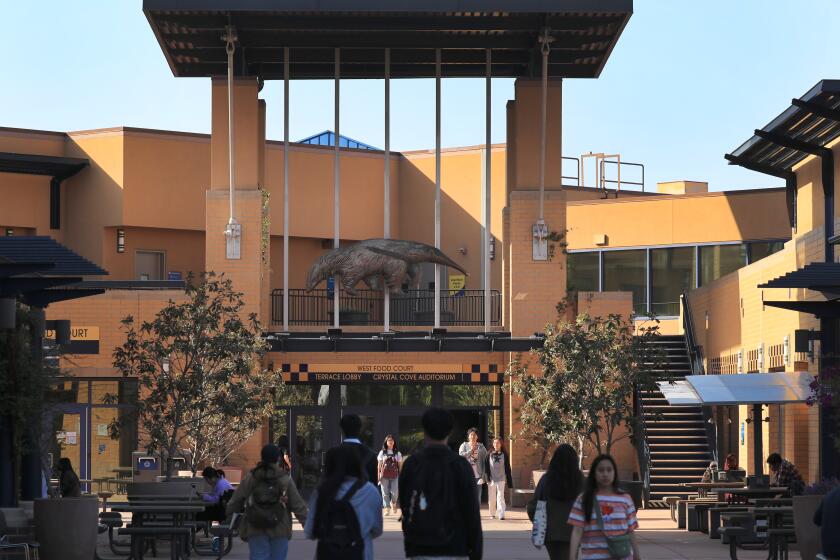Momentum is building to require California high schoolers to learn how to manage money

- Share via
California is moving closer toward requiring all public school students to learn how to manage their money — read a pay stub, balance a checking account, use credit cards wisely, save for the future and avoid scams.
The plan is to make all high school students, as a condition of graduation, take at least a one-semester class in financial literacy. Backers are going down two paths to make this happen: a November ballot initiative and state legislation. If the legislation crosses the finish line in time, the ballot initiative would be set aside.
Silicon Valley businessman Tim Ranzetta, for whom student financial literacy is a crusade, has paid for the gathering of signatures to put an initiative on the ballot.
Petition organizers said Tuesday that they are submitting nearly 900,000 signatures to county registrars across the state to qualify the California Personal Finance Initiative for the November election. The signatures still must be scrutinized; 546,651 valid signatures will be necessary.
“The pace at which Californians signed on to this measure, which would guarantee California high school students a personal finance course prior to graduation, is a testament to the popularity of this commonsense ballot proposition,” said Ranzetta, who ran one business that specialized in corporate research and another that provided document shredding services.
Ranzetta heads a nonprofit, Next Gen Personal Finance, that provides free curriculum and teacher training. He said the materials have reached nearly 100,000 teachers across the country, including more than 6,000 in California.
The legislation, introduced last month, is being carried by Assemblymember Kevin McCarty, a Democrat from Sacramento.
University of California applications rose to 250,000 for fall, driven by a rebound in transfer applicants and gains in racial, ethnic and socioeconomic diversity.
“Financial literacy is a necessity for California students,” McCarty said in a statement. “Most go into college or the workforce without any knowledge of personal finance.... Taking a finance class in high school can help students make smart money decisions that will benefit them throughout their adult life.”
Under the bill, high school students would be required to complete one semester of a financial literacy class. This course could be an already existing finance class.
The course must be offered in the 2026-27 school year, and the graduation requirement would first apply to the seniors graduating in 2029-30.
Not everyone is fully on board. McCarty introduced a similar bill last year that was amended to make financial literacy an optional component of economic classes, something that could be done already. Ranzetta dropped his support of that bill, and even the watered-down version failed to pass.
Former Los Angeles school board member David Tokofsky questions the wisdom of ballot-box curriculum mandates that could limit academic flexibility.
“If you add one more class, you probably ought to be taking out one more class,” said Tokofsky, a former social studies teacher who led a team of students to the national Academic Decathlon title. “We already require economics to graduate high school. Now we’re adding pocketbook economics, which is part of the curriculum anyway. It’s a great kind of course for summer school, online and winter session — to entice kids with something different — but putting it in the regular 8 a.m. to 3 p.m. day means biology, English, math or history will suffer.”
Separately, California lawmakers recently added an ethnic studies course to the list of mandated classes.
More parents are choosing to delay childhood vaccinations, such as the MMR vaccine. Doctors worry toddlers remain vulnerable as measles spreads.
Minimum graduation requirements include three years of English and two of mathematics, including one year of algebra. There also are two years of science, including biological and physical sciences and three of social studies, as well as two years of physical education, one year of visual or performing arts, world language, or career technical education.
There are additional requirements if a student wishes to apply to a four-year state college, and selective universities carefully evaluate a student’s advanced coursework.
Individual school districts often have their own additional requirements.
Financial literacy is typically overlooked, proponents say.
Berkeley High School teacher Crystal Rigley Janis teaches both economics and a yearlong financial literacy course and said there is a place for both. Her Advanced Placement economics course covers such topics as supply and demand, monetary policy, inflation, unemployment, gross domestic product, the peaks and recessions of the business cycle, fiscal policy and the Federal Reserve.
A teacher with 15 years experience, she created her financial literacy course about four years ago and has about 90 students spread over three classes. Her school has about 800 seniors — and all of them would benefit from the course, she said.
Some students know about cryptocurrency and are ready to learn about investing, she said, “but a lot of them come into my class because they’re scared of adulthood and they don’t know what to do. They know they don’t know how to manage their money.
“They have bad examples at home with money, and they want something different. Or they have good examples at home, and they don’t understand how their parents did it,” she said.
And sometimes, she said, “their parents do try to teach them and they’re teenagers — they don’t like to listen or learn from their parents.”
Momentum appears to be building for financial literacy training across the country, with the number of states mandating the class rising from eight to 25 over the last several years. In 2024 alone, 40 bills have been introduced in 17 states, according to a tracker maintained by Ranzetta’s organization.
The Center for Financial Literacy at Champlain College gave California an F in the topic: “Personal finance is not included in the graduation requirements, either as a stand-alone course or embedded in another course, and schools are not required to offer financial literacy courses.”
Researchers gave California some credit because the state education department offers “a robust list of financial literacy resources.”
In addition, the state’s CalMoneySmart program provides annual grants of up to $200,000 to nonprofit organizations to “provide financial education and financial empowerment programs and services for unbanked and underbanked Californians.”
A recent report by the consulting firm Tyton Partners concluded that the lifetime benefit for California students of taking a one-semester high school personal finance course is $127,000 — although such figures are hard to prove and ultimately abstract to the real-world experience of young adults.
Without understanding how money works, said Rigley Janis, “they’re going to be like the rest of America, right? Where half of people have credit card debt, live paycheck to paycheck or don’t have any retirement savings. They’re just going to fall into the existing mix, which is not a pretty mix.”
More to Read
Sign up for Essential California
The most important California stories and recommendations in your inbox every morning.
You may occasionally receive promotional content from the Los Angeles Times.













